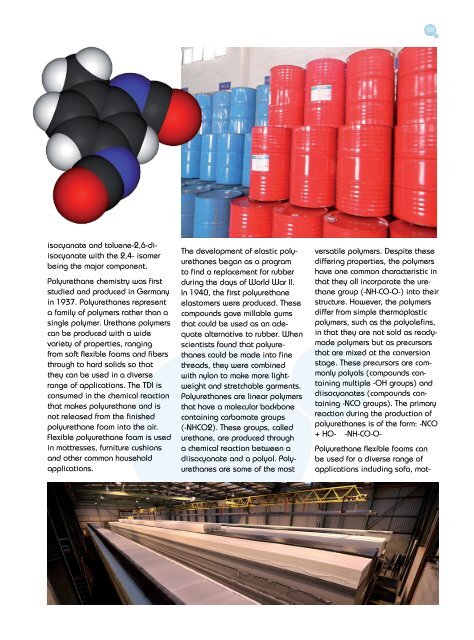SleepTech July - August 2018
SleepTech July - August 2018
SleepTech July - August 2018
Create successful ePaper yourself
Turn your PDF publications into a flip-book with our unique Google optimized e-Paper software.
99<br />
isocyanate and toluene-2,6-diisocyanate<br />
with the 2,4- isomer<br />
being the major component.<br />
Polyurethane chemistry was first<br />
studied and produced in Germany<br />
in 1937. Polyurethanes represent<br />
a family of polymers rather than a<br />
single polymer. Urethane polymers<br />
can be produced with a wide<br />
variety of properties, ranging<br />
from soft flexible foams and fibers<br />
through to hard solids so that<br />
they can be used in a diverse<br />
range of applications. The TDI is<br />
consumed in the chemical reaction<br />
that makes polyurethane and is<br />
not released from the finished<br />
polyurethane foam into the air.<br />
Flexible polyurethane foam is used<br />
in mattresses, furniture cushions<br />
and other common household<br />
applications.<br />
The development of elastic polyurethanes<br />
began as a program<br />
to find a replacement for rubber<br />
during the days of World War II.<br />
In 1940, the first polyurethane<br />
elastomers were produced. These<br />
compounds gave millable gums<br />
that could be used as an adequate<br />
alternative to rubber. When<br />
scientists found that polyurethanes<br />
could be made into fine<br />
threads, they were combined<br />
with nylon to make more lightweight<br />
and stretchable garments.<br />
Polyurethanes are linear polymers<br />
that have a molecular backbone<br />
containing carbamate groups<br />
(-NHCO2). These groups, called<br />
urethane, are produced through<br />
a chemical reaction between a<br />
diisocyanate and a polyol. Polyurethanes<br />
are some of the most<br />
versatile polymers. Despite these<br />
differing properties, the polymers<br />
have one common characteristic in<br />
that they all incorporate the urethane<br />
group (-NH-CO-O-) into their<br />
structure. However, the polymers<br />
differ from simple thermoplastic<br />
polymers, such as the polyolefins,<br />
in that they are not sold as readymade<br />
polymers but as precursors<br />
that are mixed at the conversion<br />
stage. These precursors are commonly<br />
polyols (compounds containing<br />
multiple -OH groups) and<br />
diisocyanates (compounds containing<br />
-NCO groups). The primary<br />
reaction during the production of<br />
polyurethanes is of the form: -NCO<br />
+ HO- → -NH-CO-O-<br />
Polyurethane flexible foams can<br />
be used for a diverse range of<br />
applications including sofa, mat-

















